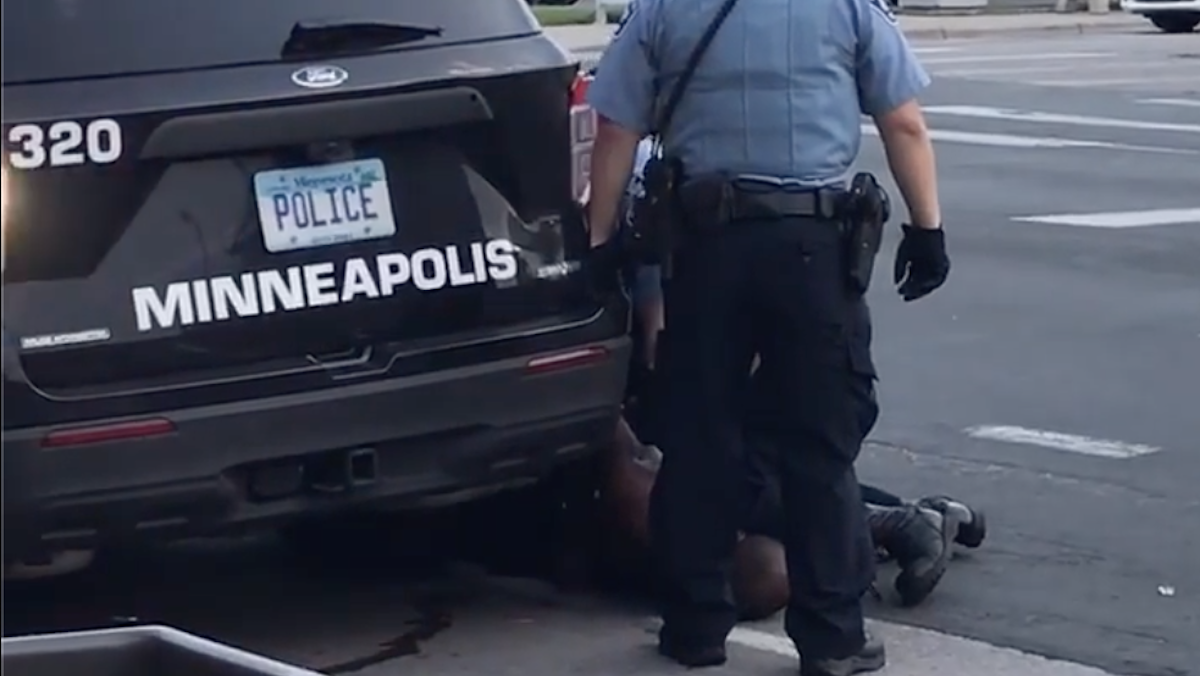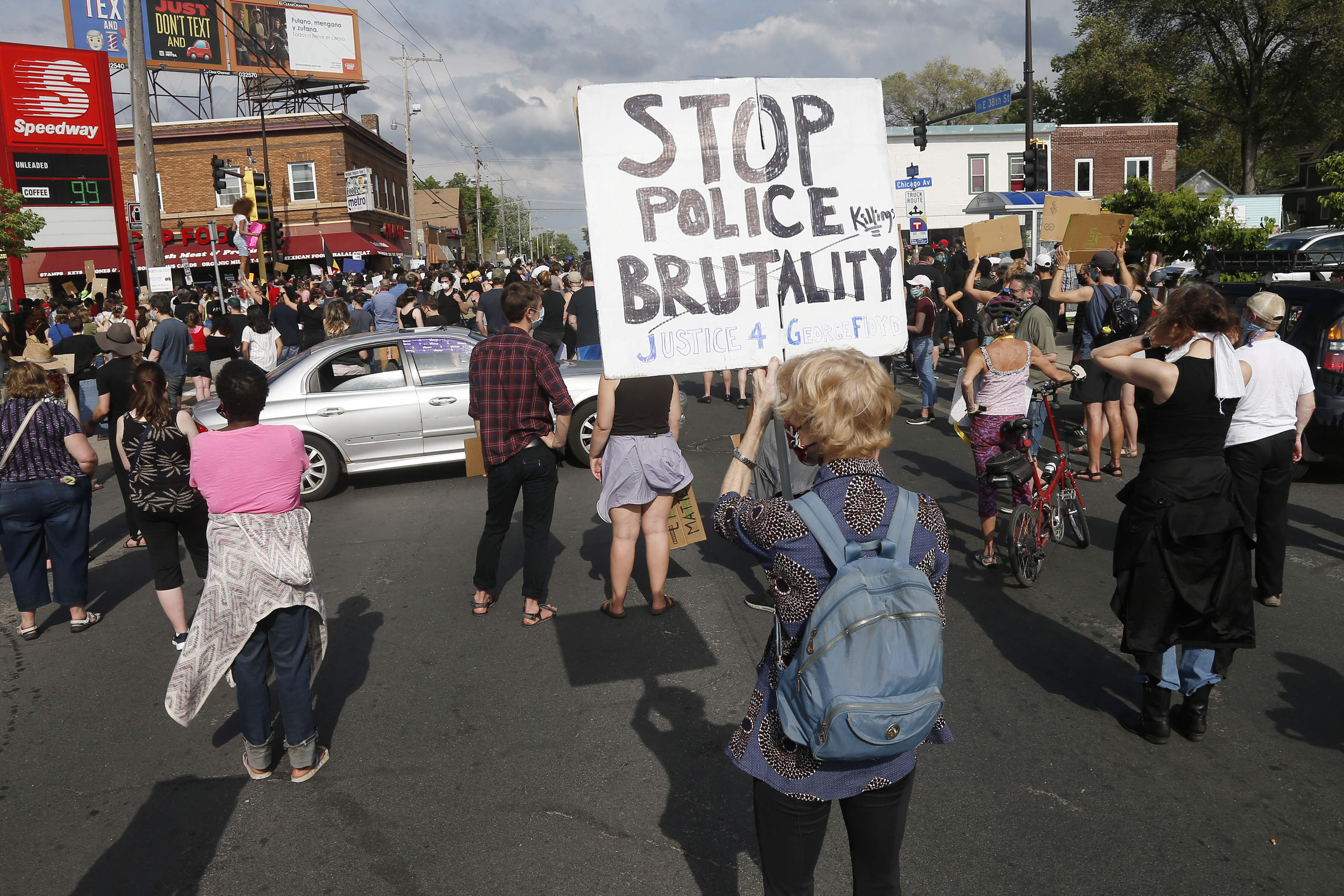The sister of George Floyd, the black man who died after a Minneapolis police officer knelt on his neck as he pleaded that he couldn't breathe, has called for the officers involved in his arrest to be charged with murder because “that’s exactly what they did.”
"They murdered my brother; he was crying for help," Bridgett Floyd said Wednesday in an interview on TODAY.
Four officers were fired a day after George Floyd's death. Bridgett Floyd said terminating the officers isn't enough.
"I don't need them to be suspended and able to work in another state or another county," she told TODAY co-anchor Hoda Kotb. "Their licenses should be taken away; their jobs should be taken away, and they should be put in jail for murder."
The officers were dismissed soon after a bystander’s video taken outside a south Minneapolis grocery store Monday night showed an officer kneeling on the handcuffed man’s neck, even after he pleaded that he could not breathe and stopped moving.
Bridgett Floyd said she hasn't watched the footage of her brother's fatal arrest.
"Me and my family are taking this very, very hard,'' said Floyd, who wore a T-shirt with the words "I Can't Breathe" during her TODAY appearance. "It's very heartbreaking. It's very disturbing to our peace. We're just doing the best that we can and making sure that we do the right thing, do what he would want us to do."
Minneapolis Mayor Jacob Frey called Wednesday for criminal charges to be filed against officer Derek Chauvin, the white policeman seen on video holding his knee on Floyd's neck for several minutes as Floyd is on the ground with his face against the pavement.
“I've wrestled with, more than anything else over the last 36 hours, one fundamental question: Why is the man who killed George Floyd not in jail?” said Frey, who is white.
Also Wednesday, President Donald Trump called the Floyd's death "very sad and tragic," and said that "justice will be served" in the case, NBC News reported.
The mayor said while most protocols advise against acting swiftly, his appeal to the Hennepin County Attorney's Office to charge the officer is based on the clarity of what he saw in the video.
"We watched five whole excruciating minutes as a white officer firmly pressed his knee into the neck of an unarmed, handcuffed black man. I saw no threat. I saw nothing that would signal that this kind of force was necessary," the mayor said. "By the way, that particular technique that was used was not authorized by the MPD, it is not something that officers are trained on and it should not be used. Period."
But despite the officers' swift dismissals, whether the death will be considered a criminal act or something less, like excessive force, is a more complicated question that will likely take months to investigate.
Minneapolis police said in a statement early Tuesday that the officers were responding to a report of a "forgery in progress" when Floyd "physically resisted." Officers later called an ambulance because Floyd "appeared to be suffering medical distress." He was transported to a local hospital "where he died a short time later."
Ben Crump, a prominent civil rights and personal injury attorney hired by Floyd’s family, told Kotb the videos that emerged online following the incident, as well as additional surveillance footage he's received from nearby businesses, tell a different story. Crump said it shows officers using "violent, lethal, excessive force" for an alleged nonviolent crime, and called for them be charged with murder.
“We have to send a message with this case,” Crump added.
The FBI and state law enforcement were investigating Floyd's death, which immediately drew comparisons to the case of Eric Garner, an unarmed black man who died in 2014 in New York after he was placed in a chokehold by police and pleaded for his life, saying he could not breathe.
But in the Garner case, local prosecutors, the NYPD’s internal affairs unit, and the Justice Department all finished investigations into the case before the officer was ultimately fired. Garner’s family and activists spent years begging for the officer to be removed.
Minneapolis police identified the other officers in the Floyd case as Thomas Lane, Tou Thao and J. Alexander Kueng, NBC News reported.
The police union asked the public to wait for the investigation to take its course and not to “rush to judgment and immediately condemn our officers.” Messages left with the union after the firings were not returned.
Protesters marched more than 2 miles Tuesday to the police precinct in that part of the city, with some damaging property and skirmishing with officers in riot gear who fired tear gas. Conflict erupted again Wednesday at the same precinct, with some protesters throwing rocks and bottles at police. News helicopter video appeared to show looting of nearby stores, including a Target, a Cub Foods and an auto parts store, with no evident police intervention.
One person was shot and killed during Wednesday night's protests. A suspect has been taken into custody, officials said. It's unclear if the shooting was related to the protests.
Another demonstration unfolded on the street outside Chauvin's suburban home. An officer told protesters that Chauvin was not there. Red cans of paint were earlier spilled on his driveway, and someone wrote “murderer” in chalk at the end of his driveway. No one answered when an Associated Press reporter knocked on the door.
Elsewhere, protesters in Los Angeles halted traffic on the 101 Freeway before dispersing. In Memphis, Tennessee, a few dozen protesters gathered outside a police precinct to voice their anger.
Police Chief Medaria Arradondo, who rose to the top job after his predecessor was forced out following the 2017 shooting of an unarmed white woman by a black Minneapolis officer, urged protesters to “be respectful.” He said he was working to change the department's culture.
“One incident can significantly bring people to doubt that,” he said.
The chief defended the department’s use of tear gas to break up Tuesday night’s protests, saying officers used it only after some people broke into a secure area that gave them access to squad cars and weapons.
Gov. Tim Walz and Minnesota’s two top law enforcement officials — Attorney General Keith Ellison and Public Safety Commissioner John Harrington, both black — promised a thorough, transparent investigation. But Walz and Ellison didn't endorse the mayor’s call to immediately charge the officer, saying the legal process needs to play out.
“I understand the emotions are running high, and I think it’s important for the mayor to channel the emotion of the people who he represents. But I think it is critical that we adhere very closely to the facts and the law and the normal process,” Ellison said.
The Hennepin County Attorney’s Office said it was “shocked and saddened” by the video and pledged to handle the case fairly. Part of that investigation will likely focus on the intent of the officers, whether they meant to harm Floyd or whether it was a death that happened in the course of police work. The FBI was investigating whether the officers willfully deprived Floyd of his civil rights.
News accounts show Chauvin was one of six officers who fired their weapons in the 2006 death of Wayne Reyes, whom police said pointed a sawed-off shotgun at officers after stabbing two people. Chauvin also shot and wounded a man in 2008 in a struggle after Chauvin and his partner responded to a reported domestic assault. Police did not immediately respond to a request for Chauvin’s service record.
In Minneapolis, kneeling on a suspect’s neck is allowed under the department’s use-of-force policy for officers who have received training in how to compress a neck without applying direct pressure to the airway. It is considered a “non-deadly force option,” according to the department’s policy handbook.
A chokehold is considered a deadly force option and involves someone obstructing the airway. According to the department’s use-of-force policy, officers are to use only an amount of force necessary that would be objectively reasonable.
But two use-of-force experts told The Associated Press that the officer clearly restrained the man too long. They noted the man was under control and no longer fighting. Andrew Scott, a former Boca Raton, Florida, police chief who now testifies as an expert witness in use-of-force cases, called Floyd’s death “a combination of not being trained properly or disregarding their training.”
“He couldn’t move. He was telling them he couldn’t breathe, and they ignored him,” Scott said. “I can’t even describe it. It was difficult to watch.”
In a post on his Facebook page, the mayor, who is white, apologized Tuesday to the black community for the officer’s treatment of Floyd, 46, who worked security at a restaurant.
“Being Black in America should not be a death sentence. For five minutes, we watched a white officer press his knee into a Black man’s neck. Five minutes. When you hear someone calling for help, you’re supposed to help. This officer failed in the most basic, human sense,” Frey posted.
Police said the man matched the description of a suspect in a forgery case at a grocery store, and that he resisted arrest.
The video starts with the man on the ground, and does not show what happened in the moments prior. The unidentified officer is kneeling on his neck, ignoring his pleas. “Please, please, please, I can’t breathe. Please, man,” said Floyd, who has his face against the pavement.
Floyd also moans. One of the officers tells him to “relax.” Floyd calls for his mother and says: “My stomach hurts, my neck hurts, everything hurts ... I can’t breathe.” As bystanders shout their concern, one officer says, “He’s talking, so he’s breathing.”
But Floyd slowly becomes motionless under the officer’s restraint. The officer does not remove his knee until the man is loaded onto a gurney by paramedics.
Several witnesses had gathered on a nearby sidewalk, some recording the scene on their phones. The bystanders become increasingly agitated. One man yells repeatedly. “He’s not responsive right now!” Two witnesses, including one woman who said she was a Minneapolis firefighter, yell at the officers to check the man’s pulse. “Check his pulse right now and tell me what it is!” she said.
At one point, an officer says: “Don’t do drugs, guys.” And one man yells, “Don’t do drugs, bro? What is that? What do you think this is?”
The Hennepin County medical examiner identified Floyd but said the cause of death was pending.
Rodney Floyd remembered his brother as a star athlete who was good to his family, kids, friends and an all around "great people person" who would help anyone who needed it.
Floyd had worked security for five years at a restaurant called Conga Latin Bistro and rented a home from the restaurant owner, Jovanni Thunstrom.
He was “a good friend, person and a good tenant,” the restaurateur told the Star Tribune. “He was family. His co-workers and friends loved him.”
The death came amid outrage over the death of Ahmaud Arbery, who was fatally shot Feb. 23 in Georgia after a white father and son pursued the 25-year-old black man they had spotted running in their subdivision. More than two months passed before charges were brought. Crump also represents Arbery's father.
Even in the coronavirus pandemic that has killed nearly 100,000 people in the U.S. and prompted police departments around the country to change how they’re doing work, the officers in the video aren’t wearing masks. In some cities, low-level arrests such as attempted forgery are skipped right now.



